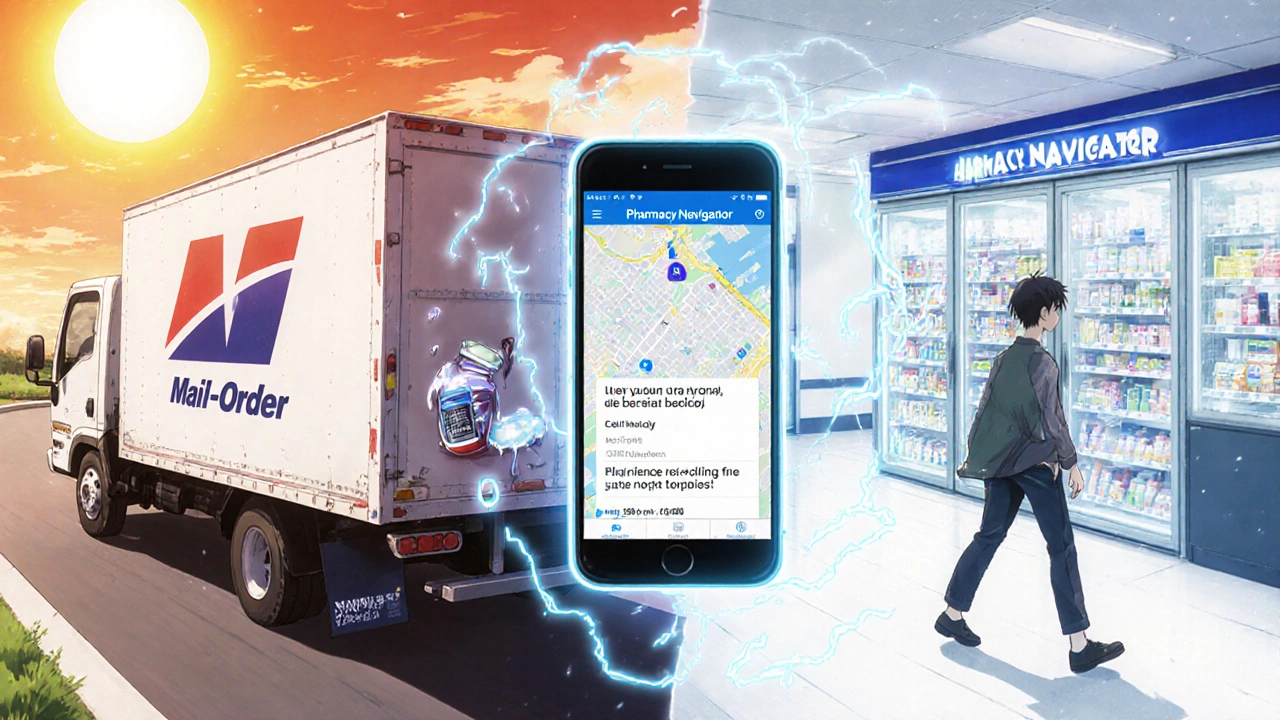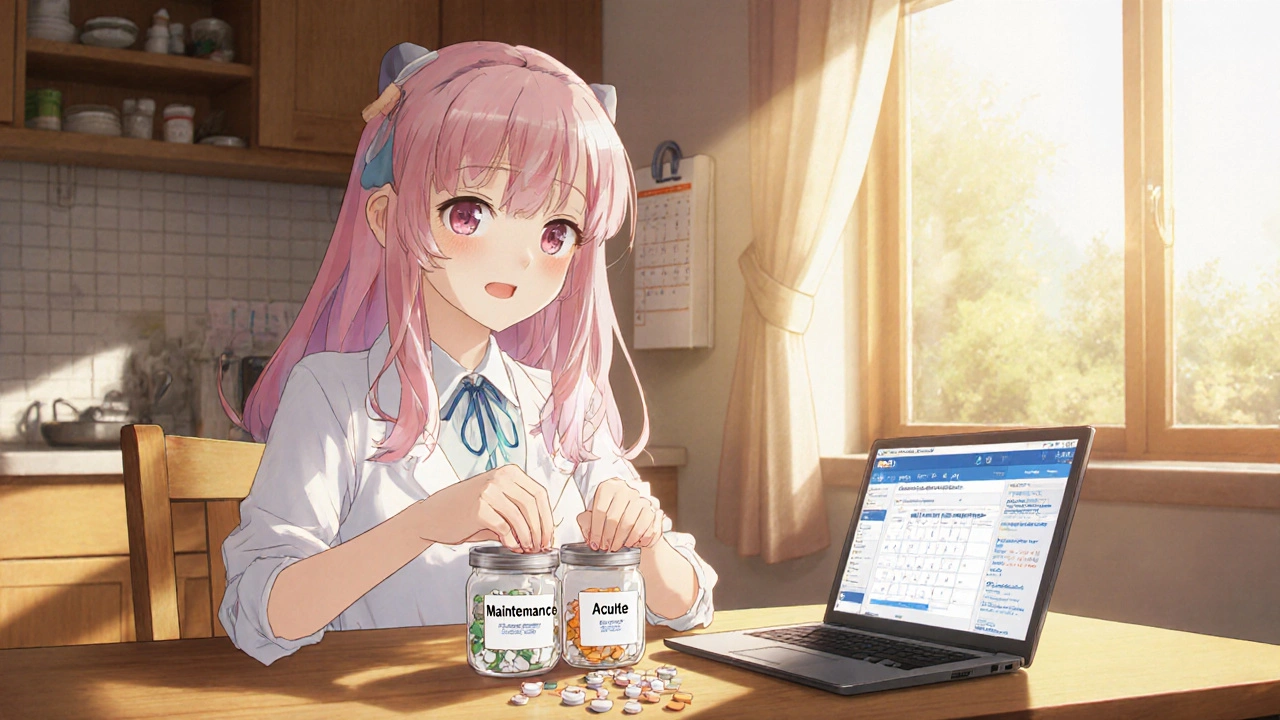Running out of your blood pressure pill on a Saturday night shouldn’t mean driving across town at 10 p.m. or paying $80 for a 30-day supply you could’ve gotten for $25. Many people don’t realize they can save hundreds a year just by using two pharmacy systems together-mail-order for the meds you take every day, and local pharmacy for the ones you need right now. It’s not complicated. It’s just not taught.
Know Which Medications Belong Where
Not all prescriptions are created equal. Start by sorting your meds into three buckets:- Maintenance meds: These are the ones you take daily for months or years-like high blood pressure, cholesterol, diabetes, or thyroid pills. These are perfect for mail-order.
- Acute meds: Antibiotics, painkillers after surgery, or inhalers for sudden asthma attacks. These need to be available today, not in 10 days.
- Variable-dose meds: Things like antidepressants or steroids where your doctor might change the dose often. These should stay local until the dose stabilizes.
Mail-order pharmacies work best for maintenance drugs because they give you a 90-day supply at once. That means fewer trips, fewer copays, and bigger savings. A 2007 study in the Journal of Managed Care Pharmacy found people saved 29% on average using mail-order for long-term meds. For example, a $45 copay for a 30-day supply of a Tier 3 generic at a local pharmacy drops to $115 for 90 days through mail-order-that’s $11.50 per month instead of $45.
Mail-Order Isn’t Always Cheaper-Check Your Plan First
Many assume mail-order is automatically cheaper. It’s not. Your insurance plan decides what’s discounted. Some plans charge the same for a 90-day supply at a local pharmacy as they do through mail-order. CVS Health’s Caremark and Express Scripts both allow 90-day fills at retail pharmacies if you ask. You just have to request it.Call your insurer and ask: “What’s my copay for a 90-day supply of [medication name] at a retail pharmacy versus mail-order?” Write it down. Some plans, especially Medicare Part D, show this clearly on their online tools. Others? You’ll need to call. Don’t guess. One user in Wisconsin saved $180 a year just by switching from mail-order to a local Walmart fill-because Walmart’s $10 generic program matched the mail-order price, but with same-day access.
Local Pharmacies Have Hidden Perks
Think local pharmacies are just for emergencies? Think again. Many offer discount programs you can use even with insurance:- Walmart: $10 for most 90-day generic prescriptions (no insurance needed)
- Costco: $4 for 30-day generics, $10 for 90-day
- CVS: $4/$10/$25 generic program
- Target: $10 for 90-day generics
These prices often beat mail-order, especially for generics. And here’s the kicker: local pharmacists are right there. They can spot interactions, explain side effects, or tell you if a cheaper alternative exists. A 2011 study found 78% of patients felt more confident with their meds after talking to a local pharmacist-compared to just 22% with mail-order phone support.
For insulin, biologics, or temperature-sensitive drugs, local pickup is safer. The FDA warns that shipping can expose meds to extreme heat or cold, which can ruin them. A vial of insulin left in a hot mailbox for three days? It’s useless. You don’t risk that walking in to pick it up.

Set Up a System-Don’t Rely on Memory
The biggest mistake people make? Waiting until they’re out of pills to order more. Mail-order takes 7-14 days to arrive. If you wait until day 28, you’re out by day 15.Here’s what works:
- Make a list of all your meds and their refill dates.
- Set phone reminders 10-14 days before each 90-day supply runs out.
- Use a free app like Medisafe or even your phone’s calendar.
- Keep a printed copy in your wallet or purse.
One Reddit user, u/MedSaver87, saved $427 a year by setting a reminder 10 days before his amlodipine ran out. He ordered his 90-day supply through mail-order, picked up his albuterol inhaler locally, and never ran out. He didn’t get lucky-he got organized.
Watch Out for the Traps
There are pitfalls. One common one: your doctor changes your dose. If you’re on mail-order, they might keep sending the old version for weeks because their system doesn’t sync with your doctor’s EHR. A user on HealthUnlocked ended up paying $65 for meds he couldn’t take because the mail-order pharmacy sent the wrong dose for two months.Another trap: insurance changes. Plans update formularies every year. What was a $10 copay last year might be $35 this year. Review your plan’s annual summary. Don’t wait for a bill to come in-check it in January.
Also, don’t assume your plan lets you switch channels easily. Some require separate authorizations for mail-order versus retail. That’s a headache. But if you call your insurer and ask for “pharmacy coordination,” they’ll often walk you through it.

Combine Strategies for Maximum Savings
The real win comes when you layer your tactics:- Use mail-order for your 3-5 maintenance meds (blood pressure, statins, metformin).
- Use Walmart or Costco for generics-even if you have insurance.
- Use your local pharmacy for new prescriptions, antibiotics, or anything you’re not sure about.
- Ask your pharmacist to check for cheaper alternatives every time you pick something up.
GoodRx’s 2023 survey of 1,200 people found 68% saved at least $150 a year using this mix. The top 32% saved over $300. How? They didn’t just pick one option-they used both.
What’s Changing in 2025
The game is shifting. Medicare’s 2024 Part D changes mean 90-day copays will be more standardized across mail-order and retail. That means the old advantage of mail-order might shrink. But new tools are rising. Epic Systems launched a “Pharmacy Navigator” in late 2023 that automatically suggests whether to use mail-order or local based on your meds, insurance, and delivery time. UnitedHealthcare’s Optum Perks now lets you switch between channels without reauthorizing.By 2025, 65% of commercial plans are expected to offer integrated systems that sync refill schedules across both channels. That’ll make coordination easier-but you still need to know how to use it.
Start Today-No Need to Wait
You don’t need a degree in pharmacy to save money. You just need to know:- Which meds are daily vs. occasional
- Where to get the best price for each
- When to order so you don’t run out
Take 30 minutes this week. Pull out your prescription list. Call your insurer. Ask about 90-day prices at Walmart and CVS. Set a reminder for your next refill. You could save more than your monthly Netflix bill-without changing your meds, your doctor, or your routine.
It’s not magic. It’s just smart.

Levi Hobbs
November 18, 2025 AT 04:57Love this breakdown. I’ve been doing this for years-mail-order for my statin and metformin, local for my antibiotics and occasional ibuprofen. Last year, I saved $387 just by switching my amlodipine to Walmart’s $10 program. No insurance needed. Just walk in, ask for the generic, and done. Also, pharmacists at CVS and Target will often tell you if a different brand is cheaper-no need to wait for a bill to surprise you.
henry mariono
November 19, 2025 AT 01:10Good info. I never thought about temperature sensitivity with insulin. I just assumed shipping was fine. Now I’m double-checking all my meds before ordering online. Small change, big difference.
Sridhar Suvarna
November 20, 2025 AT 08:11This is how you take control of your health without relying on the system. The real power is in knowing your meds and asking the right questions. No one is going to do it for you. You have to be the manager of your own care. Simple. Effective. And free.
saurabh lamba
November 21, 2025 AT 03:16So… we’re just supposed to become pharmacy detectives now? 😅 I just want my pills to work, not spend my weekends calling insurers and comparing Walmart to CVS. Life’s too short.
Kiran Mandavkar
November 21, 2025 AT 09:55Typical American solution-turn healthcare into a grocery store price war. Meanwhile, in countries with real systems, you don’t need to be a financial strategist just to get your blood pressure pills. This isn’t empowerment. It’s failure.
Eric Healy
November 21, 2025 AT 11:22Walmart $10 generics? Nah bro they’re expired. I got one last year and my BP went nuts. They cut corners. Don’t fall for the scam. Stick with mail-order or your doc’s preferred pharmacy. Trust me I’ve seen it.
Shannon Hale
November 22, 2025 AT 17:07Oh my GOD. I just realized I’ve been overpaying $200 a year on my levothyroxine because I was too lazy to call my insurer. I just did it. They said I can get 90 days at $18 at CVS. I’m crying. Not because I’m emotional-because I’m furious at myself for waiting 5 years. THIS IS LITERALLY FREE MONEY.
Holli Yancey
November 24, 2025 AT 02:48I appreciate the practical advice. I’ve been using mail-order for my antidepressants, but I always pick up my pain meds locally. It’s nice to know someone’s there to answer a quick question when I’m feeling off. The human touch matters more than people admit.
Deb McLachlin
November 24, 2025 AT 14:04While the cost-saving strategies outlined are sound, one must also consider the systemic implications of such a fragmented approach. The burden of pharmaceutical navigation falls disproportionately on the elderly and those with cognitive impairments. A truly equitable system would integrate pricing transparency and automated refill coordination at the insurer level-not require patients to become pharmacoeconomists. This is a band-aid on a broken structure.
Jeremy Hernandez
November 24, 2025 AT 15:19They don’t want you to know this. Why? Because if you save $300 a year on meds, you stop buying their fancy new drugs. Big Pharma and insurance companies HATE this. They’d rather you stay confused and overpaying. This is why they don’t teach it in med school. It’s not about health-it’s about profit.
Tarryne Rolle
November 26, 2025 AT 04:31Of course you can save money if you’re young, healthy, and have good insurance. What about people on 10+ meds? Who can’t drive? Who doesn’t have internet? Who’s on Medicare and gets hit with $500 copays because their plan changed last Tuesday? This advice is for the privileged. The rest of us just pray.
Gordon Mcdonough
November 27, 2025 AT 22:39Walmart? Costco? You think they’re not in cahoots with the big pharma lobbyists? They’re just selling you cheap pills so you don’t complain about the $2000 insulin bill next month. It’s a trap. The government’s watching. You think they want you to be healthy? No. They want you dependent. Think about it.
Kyle Swatt
November 28, 2025 AT 16:23There’s something deeply human about walking into a pharmacy, handing over your script, and having someone look you in the eye and say, ‘Hey, this dose feels off-let me call your doctor.’ That connection? It’s not a luxury. It’s medicine. The savings are nice. But the peace of mind? That’s priceless.